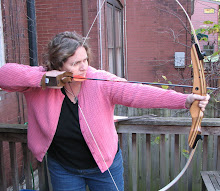It used to be, I'd go into the woods and I'd know that was an oak tree. If it had leaves, I could recognize oak trees. I was near the oak trees. I even learned, without trying, what a pin oak was. My grandmother had one in her front yard. And somehow I soaked in the knowledge that a pin oak was a red oak, and the other kind of oak was a white oak.
When Sophia was still a baby in a stroller, I realized I didn't know much about the natural environment around me. Missouri is beautiful and I felt bad that I didn't know the birds and trees and flowers. I began to study. I especially fell in love with oak trees. Not only were they divided into red and white, but each category had many species within. There were burr oaks and basket oaks and chinquapin oaks and scarlet oaks. I studied in books and went out into the wilderness. I held leaves and acorns in my hand and all my new knowledge was jumbled up in my head, but in a fascinating new way. I wanted to know and I wanted to know precisely and expertly.
I narrowed in on a street tree outside my front door, an oak of the red oak variety, but it began to dawn on me that it didn't fit. I would observe bud ends and baby leaves and acorns and bark and it didn't fit. I got better books and learned that oaks hybridize, and more than that: their hybrids are often fertile, leading to different hybrids themselves. The possibilities were endless. My neighbor Anne mentioned to me that Forest Park had to bring in an oak expert form the East Coast to figure out what species, or combination of species, a certain grove belonged to. An oak expert. There was no way I'd ever learn enough to be an expert.
Daunted, but still enthusiastic, I got a blank book and started recording every oak tree I ran across. Most fit simply where they belonged: blackjack, blue, white, willow, laurel, and so on. Others were mysterious. I learned Latin terms. Quercus velutina. Quercus alba.
When I went into the woods, I would point out oaks incessantly. It took me a long time to realize that many people didn't care. It didn't matter to them if it was an oak or a maple or a Kentucky coffee tree. They'd come for the shade. So I backed off. But in withdrawing from persistent identification of oaks, I didn't stop naming them in my head. I still saw them for what they were.
I had an opportunity to go walking at night this past weekend at a girl scout camp. We walked in darkness to adjust to night light, simply for the fun of it. Walking past an open field, I saw the form of the white oak in almost the center. I didn't point it out to the group of 9 year old girls walking along with me. They would note it or they wouldn't and it didn't matter. I knew it was there, gnarled and glorious, 100 years at least standing alone in that meadow. I loved it from afar in the darkness, seeing in my mind the shape of its leaves, the size of the acorn caps on the ground below it, the root structure stretching deeply underground. And that was enough.
Conversations with Middle Schoolers #55
10 years ago


0 comments:
Post a Comment